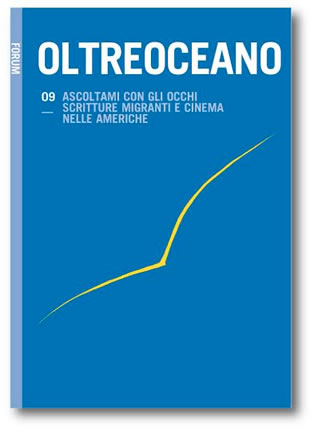Distancias geográficas, distancias visuales
Keywords:
imaginación, viaje, cine, literaturaAbstract
La película “Distancia” (2010) del director guatemalteco Sergio Ramírez se basa en hechos reales acontecidos en los años recientes. Durante los años ’80, en Guatemala se realizó un genocidio contra la población indígena. Esto provocó la muerte de 200 mil personas, la fuga a México de más de 50.000 mayas y un fenómeno poco conocido: la huida hacia las montañas de un millón de personas, que recibieron el nombre de CPR (Comunidades de población en resistencia). El film cuenta una historia derivada de esa fuga. El artículo analiza el film y, a través de ese análisis, trata de demostrar como la distancia geográfica se convirtió en una distancia simbólica, metáfora de la distancia que separa a las diferentes etnias de Guatemala.
Distanze geografiche, distanze visive
Il film “Distancia” (2010) del regista guatemalteco Sergio Ramírez è basato su fatti reali successi negli anni recenti. Durante gli anni ’80, in Guatemala fu perpetrato un genocidio contro la popolazione indigena. Ciò provocò la morte di duecentomila persone, la fuga in Messico di più di cinquantamila maya e un fenomeno poco conosciuto: la fuga verso le montagne di un milione di persone, che ricevettero il nome di CPR (Comunità di popolazione in resistenza). Il film racconta una storia derivata da tale fuga. L’articolo analizza il film, e tenta di dimostrare come la distanza geografica divenne distanza simbolica, metafora della distanza che separa le diverse etnie del Guatemala.
Geographic Distances, Visual Distances
The film “Distancia” (2010) by Guatemalan director Sergio Ramírez is based on real facts occurred in recent years. During the 80’s, in Guatemala a genocide was perpetrated against the indigenous population. This caused the death of 200,000 people, the leak to Mexico of more than 50,000 Mayan and a little-known phenomenon: the exodus to the mountains of one million people, which received the name of CPR (Communities of Population in Resistance). The film tells a story derived from such escape. The article analyzes the film, and through that analysis tries to show how geographic distance became a symbolic distance, metaphor of distance between the different ethnic groups of Guatemala.
Downloads
References
Albizúrez, M. Á. (2006): Tiempo de sudor y lucha. México: Praxis.
Argueta, L. (Dir.) (1994): El silencio de Neto. Guatemala: Buenos Días. Film.
Cardoza y Aragón, L. (1986): El río. Novela de caballerías. México: FCE.
Casaus, M. E. (2011): Linaje y racismo. Guatemala: FyG.
Cordón, J. H. (Dir.) (2008): Gasolina. Guatemala, Estados Unidos & España. Film.
Figueroa Ibarra, C. (2011): El recurso del miedo, Estado y terror en Guatemala. Guatemala: FyG.
Figueroa, R. & Elías Jiménez, E. (Dirs.) (2011): Toque de queda. Film. Guatemala: Casa Comal.
Fukunaga, C. (Dir.) (2009): Sin nombre. México & USA. Film.
García Canclini, N., (1990): Culturas híbridas. Estrategias para entrar y salir de la modernidad. México: Grijalbo.
Kendall, M. (Dir.) (2012): La camioneta. Estados Unidos & Guatemala: Ek Balam Producciones & Follow Your Nose Films. Film.
Martínez, S. (1973): La patria del criollo. San José de Costa Rica: Universitaria Centroamericana.
Nava, G. (Dir.) (1983): El Norte. Estados Unidos & ReinoUnido: Thomas. Film.
Oficina de Derechos Humanos del Arzobispado de Guatemala (ODHA) (1998): Guatemala, nunca más. Informe del Proyecto Interdiocesano de Recuperación de la Memoria Histórica. Recuperado de http://www.odhag.org.gt/publicaciones/remhi-guatemala-nunca-mas/
Oficina de Servicios para Proyectos de las Naciones Unidas (UNOPS) (1999): Memoria del silencio. Guatemala. edición digital. Recuperado de http://www.centrodememoriahistorica.gov.co/descargas/guatemala-memoria-silencio/guatemala-memoria-del-silencio.pdf
Queimada Díez, D. (Dir.) (2013): La jaula de oro. México. Film.
Ramírez S. (Dir.) (2012): Distancia. Guatemala. Film.
Rodríguez, Ch. (Dir.) (2006): Estrellas de la línea. España: T. Cimadevilla, Delgado, B. & Rodríguez Ch. Film.
St. Michael & All Angels (2014): Episcopal Church and The CPR-Sierra’s, Guatemala Project. Recuperado de http://www.cprguatemalaproject.org/About%20the%20CPR.html
Vargas Llosa, M. (1971): Historia de un deicidio. Barcelona: Barral.
Downloads
Published
How to Cite
Issue
Section
License

This work is licensed under a Creative Commons Attribution-NonCommercial-ShareAlike 4.0 International License.
The authors undertake to comply with the following conditions, which are considered accepted at the time of submission of their contributions.
The sending of a text implies that it is unpublished and not submitted to be published elsewhere.
1. If accepted, the author shall confer on the publisher the right to publish and distribute it both in paper form and in the online electronic edition. The published articles will be downloadable and made available in open access.
2. Provided that it correctly indicates that the first publication took place in the journal Oltreoceano. Rivista sulle migrazioni the author has the right to: a) reproduce the article in separate extracts or collected in a volume; b) publish the article on their personal website or teaching site provided that these sites are of a non-commercial nature; c) deposit the article in online archives of a non-commercial nature, linked to the institution they belong to or as part of projects for the non-commercial dissemination and open access of scientific works.
The use of contributions by third parties, for commercial or otherwise unauthorized purposes, is not allowed. The publisher declines all responsibility for the unauthorized use of the material published in the journal.












